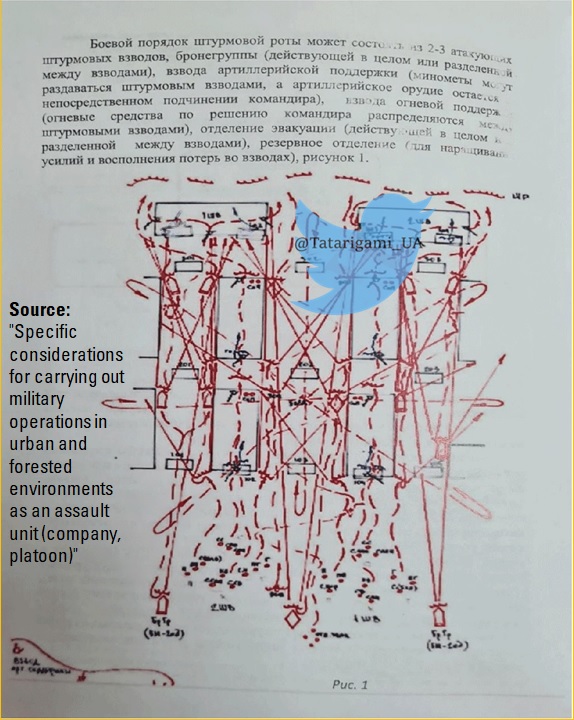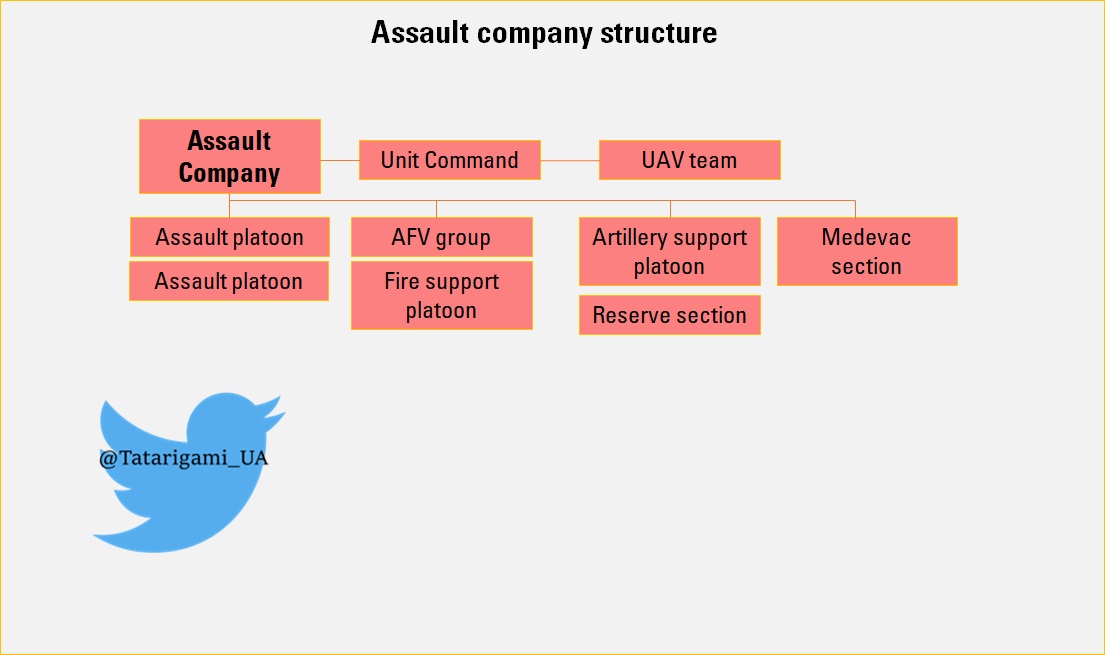Russian military appears to be adopting a new tactical-level organizational structure to break through the Ukrainian defensive lines in eastern Ukraine, as per a Russian Army manual ‘captured’ by Ukraine’s military.
The documents were shared by a famous Twitter handle named @Tatarigami_UA, belonging to a Ukrainian Army reserve officer. He is known to be deployed near the frontlines in Vuhledar.
The documents, according to @Tatarigami_UA, describe a new organizational structure called the Assault Detachments, which involve infantry advancing on foot, supported by armored vehicles on their flanks.
Theoretically, such an organizational structure is believed to offer lower-level officials more means to carry out battlefield tasks instead of depending on assets controlled by higher-echelon leaders.
Battalion Tactical Group
Russian military relied on the organizational structure of battalion tactical groups (BTG), which entailed every regiment or brigade pooling its equipment to form two or three reinforced BTGs centered around mechanized infantry backed by a tank company and two or three artillery batteries.
However, these BTGs did not enjoy much success in the large-scale multi-pronged invasion, as they were heavy on vehicles and long-range firepower but lacked the infantry to protect these assets, which was reflective of the Russian Army’s intention to bombard Ukrainian positions from long distances, instead of engaging in close combat battles.
The lack of infantry cover and the failure to secure the urban terrain before penetrating with armored vehicles allowed Ukrainian troops to get into good positions for ambushing the Russian armored columns with anti-tank guided munitions (ATGMs).
Also, the massive multi-pronged assault on Ukraine created long supply lines vulnerable to Ukrainian interdiction, which led several Russian vehicles to run out of fuel and spares, forcing their crew to abandon them.
The failure appears to have led the Russian military to reconsider its BTG concept. This is possibly why the Russian Army looks different in 2023 than the one that invaded Ukraine a year earlier.
It is also important to consider the vast equipment losses that Russia suffered forced the Kremlin to bring out Soviet-era weapons in Ukraine, such as the T-62 tanks, D-20 towed howitzers, and BTR-50 Armored Personnel Carriers (APCs).
Apart from that, the Russian Army has also lost a lot of workforce throughout this grueling war of attrition that has entered its second year. However, this was substantially replenished through partial mobilization by Moscow last fall.
The new Russian Army appears to be prioritizing sustained assaults on fortified Ukrainian positions in Donbas which would involve close-combat battles aimed at scoring tactical victories which could eventually stack up to form operational gains for Russia, as is being observed in Bakhmut, Avdeevka, and the western Donetsk region.
That said, experts also suggest that Russians do not want to risk their heavy equipment in the current weather conditions, which could make it easier for Ukrainian forces to target them. Therefore, they have chosen not to use more traditional mechanized maneuver warfare tactics.
Reports based on videos from the Bakhmut region suggest that the Russian forces have made significant tactical advances in the area on the back of their current tactics.
Assault Detachment Organization
The new Assault Detachment structure, as reportedly described in the Russian Army manuals claimed to have been captured by the Ukrainian forces, is equivalent to a reinforced battalion comprising two or three ‘assault companies.’
Overall, an assault detachment can be customized as per mission requirements and consists of two or three assault companies, a command unit, an artillery support unit, and other units such as surveillance, tanks, electronic warfare, air defense, fire support, UAV (Unmanned Aerial Vehicles), medical evacuation (Medevac), flamethrowing, assault engineering, reserve, equipment recovery. Page From A Captured Russian Army Manual Shared By A Ukrainian Army Reserve Officer (@Tatarigami_UA/Twitter)
Page From A Captured Russian Army Manual Shared By A Ukrainian Army Reserve Officer (@Tatarigami_UA/Twitter)
 Page From A Captured Russian Army Manual Shared By A Ukrainian Army Reserve Officer (@Tatarigami_UA/Twitter)
Page From A Captured Russian Army Manual Shared By A Ukrainian Army Reserve Officer (@Tatarigami_UA/Twitter)It also includes one or two shorter-range artillery batteries for firepower, one armed with six towed D-30 122-millimeter howitzers, the other with 2S9 self-propelled 120-millimeter mortars.
Of these, the tank units are equipped with three T-72 main battle tanks (MBTs), flamethrowing units are armed with 12x RPO-A thermobaric rocket launchers, the fire support group is armed with two AGS-17 automatic grenade launchers and two Kord 12.7-millimeter heavy machine guns, the air defense units are equipped with two ZU-23 automatic cannons and three man-portable air defense systems (MANPADS) like the Igla-M, and Armored Recovery Groups (ARGs) are fitted with BREM-L towing vehicle.
Assault Company
The assault company is the central unit of an assault detachment, centered around two assault platoons consisting of 12-15 personnel reinforced by three fire support platoons.
Overall, it has a command unit, a UAV team, assault platoons, an artillery support platoon, a fire support platoon, an armored fighting vehicle (AFV) group, a reserve group, and a medevac section. Assault Company Structure (@Tatarigami_UA/Twitter))
Assault Company Structure (@Tatarigami_UA/Twitter))
 Assault Company Structure (@Tatarigami_UA/Twitter))
Assault Company Structure (@Tatarigami_UA/Twitter))The artillery support platoon has one D-30 howitzer or 2S9 vehicle and two medium 82-millimeter mortars or heavier 120-millimeter systems. While the mortars are assigned to assault platoons, company commanders control the howitzers.
The fire support platoon is equipped with various direct-fire support weapons, including two AGS-17 grenade launchers, two Kord heavy machine guns, two long-range anti-tank guided missile launchers, and possibly two long-range sniper teams.
The AFV group comprises one T-72 MBT and four BMP fighting vehicles or lightly armored BMD-2 vehicles. However, these troop-carrying vehicles do not blend into the infantry squad as Russian mechanized units are known to be, cause their primary role seems to be maneuverable fire support using their automatic cannons, with troop transport being a secondary role.
From an operational standpoint, they can remain grouped or be dispersed between assault platoons. Apart from that, there is also one MBT for heavier fire support.
Assault Platoon
As for the assault, the platoon comprises 12-15 personnel, divided into 4-5 three-person teams, each equipped with a mix of weapons based on mission requirements.
The teams include two tactical groups, an advance team, a command team, and a reserve fire support team. The Assault platoon is advised to advance in a diamond-style formation.
Tactical Directives For An Assault
The captured Russian Army manual also provides specific tactical directives, listed by @Tatarigami_UA in his Twitter thread. They are as follows:Assaults on fortified positions must begin within a minute of the end of the supporting artillery bombardment.
Drones are recommended to be used only for surveillance, not battle monitoring, to avoid losing them.
Occupying trenches abandoned by Ukrainian troops is prohibited because of the risks of booby traps or these trenches marked as targets for artillery fires.
The assault platoons or companies must not evacuate the wounded but instead provide the coordinates of the injured to the medevac units.
The recommended firing method for automatic grenade launchers (AGLs) is indirect fire, with a preferred firing range of 600-1,700 meters. Ukrainian forces also use their own AGLs this way.
Assault platoons are advised against moving through open spaces and must stick to the cover offered by tree lines. File Image
File Image
 File Image
File ImageNew Tactics Inspired By Wagner PMC Forces
@Tatarigami_UA notes that decision to switch to the Assault detachment seems to be influenced by advances in the Bakhmut region by the Wagner PMC (Private Military Company) forces and the massive attrition of Russian vehicles and weaponry since February 2022.
In a previous Twitter thread, @Tatarigami_UA discussed the tactics of Wagner forces in the Bakhmut region based on accounts from Ukrainian forces deployed there.
“Wagnerites usually break down into small assault teams of 3-4 people. The first team is usually led by a “scout” who is tasked to observe and locate mined areas ahead. He is followed by two regular riflemen and a machine gunner,” writes @Tatarigami_UA in this Twitter thread, supposing the Wagner forces are attacking a tree line defended by Ukrainian trenches, which is quite a common occurrence in this war.
These assault units are covered by fire support deployed on a tree line that is 90 degrees to the line of advance. The fire support units are armed with mortars, automatic grenade launchers (AGLs), or even rocket-propelled grenades if the AGLs are lacking.
Soon as the artillery fire ends, the fire support teams open fire with AGLs/RPGs and a machine gun to suppress the defenders and prevent them from taking any measures, allowing the assault teams to advance toward the Ukrainian trenches.
No comments:
Post a Comment